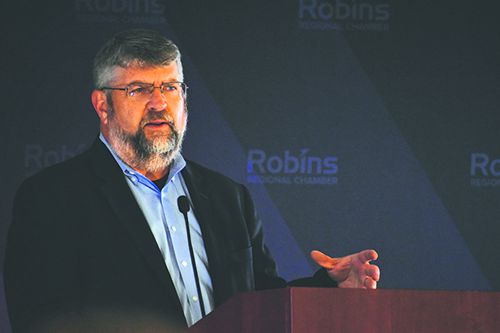Robins Regional offers economic outlook for county

WARNER ROBINS, Ga. — Robins Regional Chamber brought back one of their former events from a hiatus this week: The Houston County Economic Outlook. With business owners, local leaders and government representatives in attendance, economists offered their take on the current economy from a national and local level — the good and the bad.
Michael Chriszt is the vice president and regional engagement officer for the Federal Reserve Bank of Atlanta’s Corporate Engagement Office. He offered some brief insight on the economy from a federal level.
Chriszt offered several key notes:
-Private spending, which accounts for 70% of the overall economy, has held up through the first quarter of 2023, but is beginning to slow down. Retail sales and food service have dropped “for the first time in a long time,” below 2%. Chriszt said this may be due to money saved prior to or during the pandemic running low or increased interest rates from the federal reserve. Consumer confidence in the US economy is showing signs of slowing as well.
-Consumer purchased rose back to normal quickly after pandemic shutdowns, but have begun to slow.
-The Federal Reserve has two jobs: limiting inflation and maximizing employment. Inflation remains high, according to Chriszt, as a result of demand outstripping supply during and after the pandemic. Supply is beginning to make a positive turn, and interest rates are limiting demand so that inflation can make a downward turn. Chriszt reported that inflation remains above 5% — the Federal Reserves goal is 2%.
-Wage growth has flattened, but remains high — this, according to Chriszt, is not true wage growth, but wage growth as a result of inflation. If this continues, it could cause a “wage-price spiral,” a scenario that cause wages and prices to rapidly increase to accommodate for one another.
-Unemployment “is the lowest it’s been in decades, about 3.4, 3.5%” The amount of jobs being added to the economy by jobs is, however, beginning to slow, but still robust. Meanwhile, job vacancies are high as a result of early retirements, employees returning to school, family responsibilities and the “shadow labor force,” — individuals who don’t work for a company, but make money their own way. Prime-age employment has returned to the same level it was at prior to the pandemic.
-By the fourth quarter of 2023, the Federal Reserve is projecting that the unemployment rate is expected to rise to 4.5%, with inflation lowering to 3.3%. These numbers were developed in March of this year, with new projections coming out in June. Risks to these results come in the form of the debt ceiling decision from Congress and recent events causing banks to tighten credit standards.
“Overall economic activity is slowing, inflation expectations are moderating but it’s going to take some time to get back to our 2% target, employment growth also appears to be moderating but demand for workers still outstrips supply,” Chriszt said. “The Federal Reserve is on pause — we’re going to wait and see what the impact of this year-long series of interest rates are, and were going to assess what the impact of potentially tighter credit conditions are on the economy before moving forward.”
Greg George is an associate professor of economic analysis at Middle Georgia State University. He provided his professional understanding of the local economy using a technical and judgmental form of economic forecasting, using economic trends to form his predictions.
According to George, the good news and bad news for Houston County’s economic outlook are the same: unemployment is very low, wages are up, inflation is ongoing and interest rates are currently high.
-Unemployment is low, 3.1% in Houston County, making it easy to get a job. Wages are by 6% annualized. Employers, on the other hand, are having a hard time finding workers because citizens seeking jobs have an easier time finding them. Higher wages pressure growing inflation. This unemployment rate remains steady in Houston County, and the number of people returning to the job market continues to grow.
-Interest rates are higher than they’ve been recently, but not so high they’re crushing. They’ve risen, however, extremely quickly — from 0 to 5% in just a year. They may continue to rise if inflation continues.
-Houston County’s housing market has stabilized since the rapid market during the pandemic, but still very hot. This pressurizes housing prices, and adds additional pressure to inflation.
-The percentage of consumers with bad credit in Houston County remains low, and has dropped to about a third of what it was at the start of 2020.
-The number of new businesses here locally continues to grow.
“Where are we headed? The fact that Warner Robins and Houston County has such a low unemployment rate, that’s gong to keep the labor markets tight in the short run, and the lending market, like I said, we’re going to see an increase in interest rates,” George said. “Wage inflation does become a big problem with inflation because as wages go up, that transfer through into prices.”
“The good news, eventually the labor market will correct, and the good thing about wages going up is that brings people out of retirement, it brings people who are out of the labor force back into the labor force.”
George reported that inflation is now moving in the right direction, and that despite the bad news, college graduates are moving into a strong market for their needs.
Following George’s presentation, the event was brought to an end. For more information, or to look over the slides and charts used by both presenters, visit https://www.robinsregion.com/outlook23/.
HHJ News
Before you go...
Thanks for reading The Houston Home Journal — we hope this article added to your day.
For over 150 years, Houston Home Journal has been the newspaper of record for Perry, Warner Robins and Centerville. We're excited to expand our online news coverage, while maintaining our twice-weekly print newspaper.
If you like what you see, please consider becoming a member of The Houston Home Journal. We're all in this together, working for a better Warner Robins, Perry and Centerville, and we appreciate and need your support.
Please join the readers like you who help make community journalism possible by joining The Houston Home Journal. Thank you.
- Brieanna Smith, Houston Home Journal managing editor



